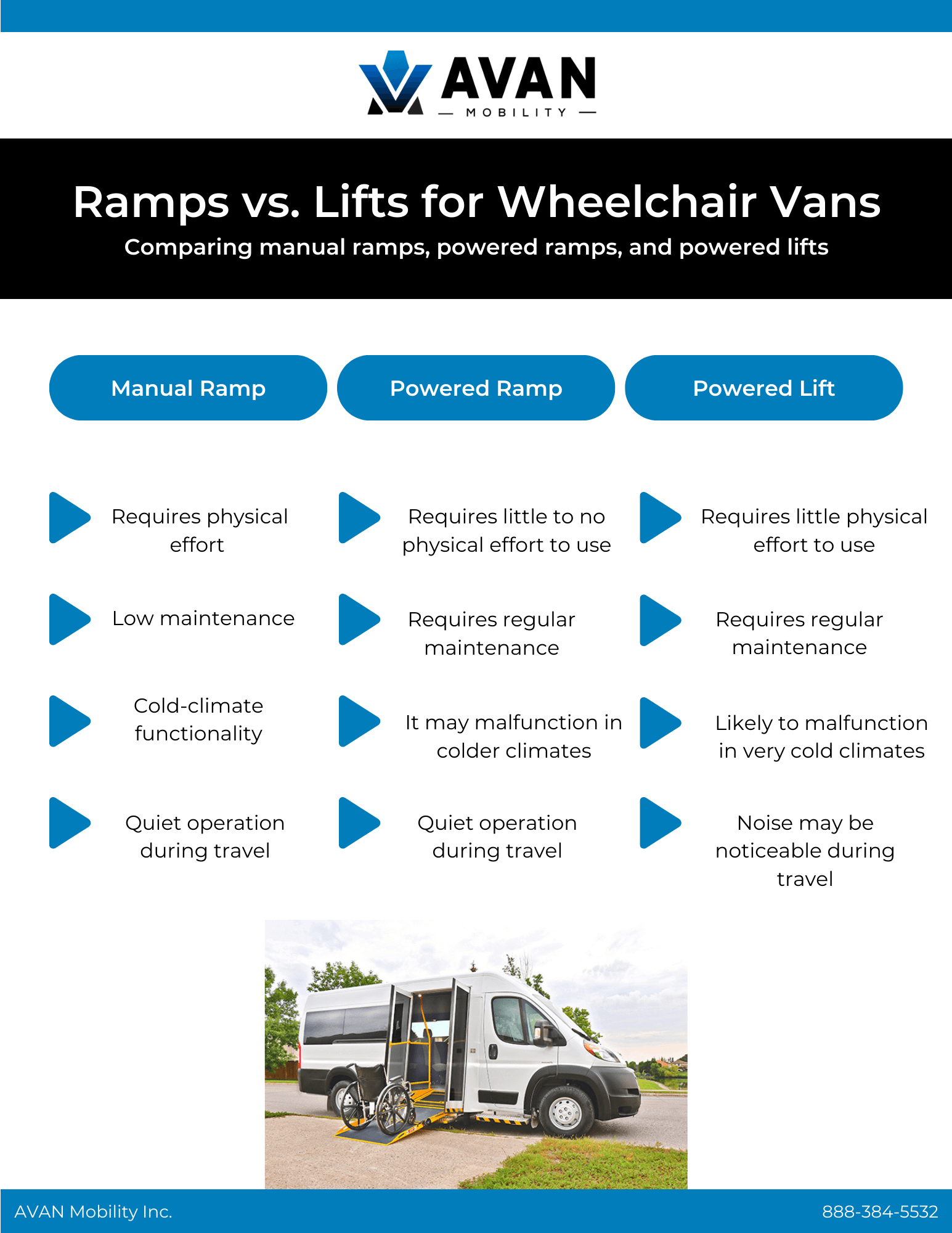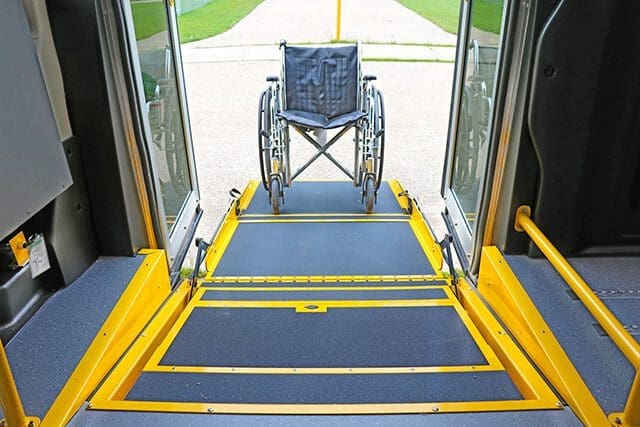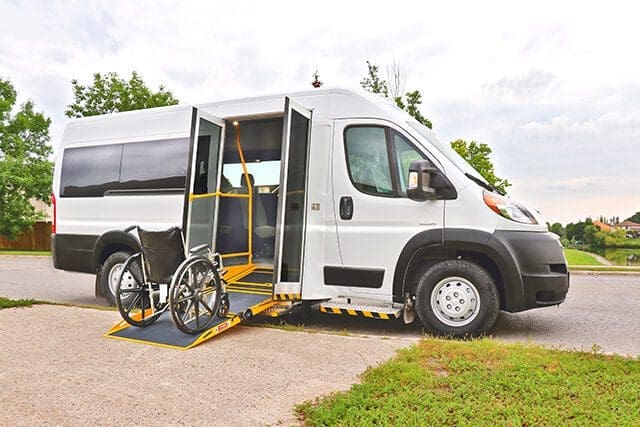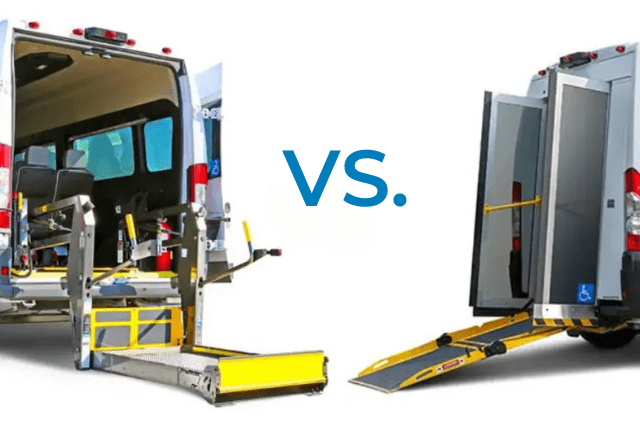Are you part of an organization looking to buy a wheelchair van and feeling confused about choosing a ramp or a lift? The decision between ramps vs. lifts for wheelchair vans can be overwhelming.
You worry about making the right choice because your vehicle’s accessibility will directly impact the comfort and convenience of those who rely on it. It’s a big decision, and getting it wrong could mean extra hassle for your clients and higher costs down the line for your organization.
At AVAN Mobility, we understand your concerns. We’ve been in this business for over 10 years, helping reduce barriers to healthcare and transportation with our mobile healthcare and accessible transportation solutions. We know how important it is to find the right fit. While we’re experts in our field, we understand there are other options out there, and we aim to provide unbiased, helpful information.
In this article, you’ll discover the key differences between wheelchair ramps and lifts. This information will help you make the best decision for your organization and the people you serve.
Ramps vs. lifts for wheelchair vans: What are the differences?

Ramps and lifts both help people get in and out of wheelchair vans, but they work in different ways. A ramp is a sloped platform that starts on the ground and goes up into the van, making it easy to roll in. A lift, on the other hand, raises the person straight up until they are level with the van floor, then they can move inside.
In the next sections, we’ll compare ramps vs. lifts for wheelchair vans using eight factors:
- Type
- Stretcher access
- Noise level
- Passenger comfort
- Rear or side entry
- Cold weather functionality
- Cost
- Ease of use
Wheelchair van ramps

Let’s start by looking at the different types of wheelchair van ramps.
Type
At AVAN Mobility, we understand that different needs call for different solutions. That’s why we offer two types of ramps: manual and powered. Each type serves a unique purpose and can be a perfect fit, depending on your specific situation.
Manual ramp: Think of the manual ramp as the trusty, straightforward option. To use it, you just unlatch it and lower it to the ground. It’s that simple. Whether someone needs to roll up in a wheelchair or walk up with a walker, this ramp gets the job done without any fuss. We use these reliable manual folding ramps on our full-size, rear-entry vans. It’s a no-nonsense solution for straightforward access.
Powered ramp: The powered ramp is like the tech-savvy cousin of the manual ramp. It’s hydraulic, meaning it’s powered by liquid pressure, and it comes with a host of cool features:
- Heavy-duty, transit grade: Built to withstand a lot of use.
- Unobtrusive when stowed: It won’t block the entryway, keeping things clear.
- Flexible access: Can stay stowed for walk-on passengers.
- Strong: Can handle up to 1,000 lbs.
- Manual option: Integrated handles for manual use if needed.
Stretcher access
Our manual ramps can be equipped with a swing-and-fold feature. This means the ramp can move out of the way, providing full access to the rear entrance of vehicles like the Ram Promaster and Ford Transit. This feature is especially useful for non-emergency patient transport services that need to handle stretchers as well as wheelchairs.
Noise level
When considering ramps vs. lifts for wheelchair vans, noise level can be an important factor, especially if you’re looking for a quiet ride.
Manual ramps are generally very quiet. Since they don’t rely on hydraulics or motors, there’s no mechanical noise when they’re being deployed or folded. Plus, with fewer moving parts, there’s less chance of rattling or squeaking while you’re driving.
Passenger comfort
Passenger comfort is another key factor to think about when choosing between ramps vs. lifts for wheelchair vans.
While manual ramps are practical, they can sometimes be steep and lengthy. This means that pushing a large or heavy wheelchair up the ramp might be physically demanding for the person assisting. The ramp’s angle can also make the ride a bit bumpy for the passenger, which might not be ideal for everyone.
Rear or side entry
Another important consideration is whether you want a rear-entry or side-entry vehicle.
Manual ramps offer flexibility in this regard. They can be installed on both rear entry and side entry full-size vans. This gives you options depending on your space and accessibility needs.
Cold weather functionality
If your organization is based in a region that experiences harsh winters, cold weather functionality is a key consideration.
Manual ramps: Manual ramps don’t rely on hydraulic systems, so they’re not affected by extreme cold. This makes them a reliable choice for places with severe winter conditions, like Minnesota or North Dakota. With a manual ramp, you won’t have to worry about the cold causing any mechanical issues.
Powered ramps: Powered ramps, however, can be tricky in very cold weather. The hydraulic mechanism might struggle to operate in freezing temperatures, leading to potential breakdowns. If your organization is in a place like Northern Minnesota, where winters are long and harsh, you might want to think twice about using a powered ramp.
Cost
Manual ramps: Manual ramps are cheaper upfront and a budget-friendly option. But they do need some physical effort to operate.
Powered ramps: Powered ramps cost more initially but are super convenient. They’re easy to use with the push of a button, especially in busy areas.
Don’t just focus on cost—think about what works best for your staff and clients.
Ease of use
When deciding between a manual ramp and a powered ramp, consider who will be using it daily. The ease of operation is a critical factor.
Manual ramp: If you choose a manual ramp, you must know that it requires some physical effort. Your team will need to fold and unfold the ramp, which might be a daily task. However, don’t worry too much—our manual ramps come with a spring-assist mechanism, making them lighter and easier to handle. They’re designed to minimize the strain, but there’s still a bit of lifting involved.
Powered ramp: On the other hand, a powered ramp is all about convenience. It operates with the push of a button, eliminating the need for physical strength. If your staff isn’t equipped to handle the daily lifting or you want to ensure the process is as smooth and effortless as possible, a powered ramp is the way to go. It takes care of the heavy lifting for you, making it a stress-free option.
Wheelchair van lifts

Type
Imagine a hydraulic platform that makes getting in and out of a van a breeze. That’s what a powered lift does. It extends from the back of the van and gently lowers to the ground. Once the wheelchair user is on board, the lift smoothly raises them up to the van’s floor level. From there, they can roll right into the van and get securely fastened for the journey.
Stretcher access
Lifts work differently than ramps when it comes to stretcher access. Unlike ramps, lifts aren’t designed to accommodate stretchers. If your organization needs to transport stretchers frequently, a ramp is the better choice for ease of access and safety.
Noise level
Powered lifts can be noisy, especially when you’re driving. Since they’re stored against the back doors of the van, they can rattle when you hit bumps or rough roads. This is something to keep in mind if an extremely quiet ride is important for your passengers.
Passenger comfort
Making sure passengers are comfortable is very important. Sometimes, the motion of a powered lift can be intimidating for some individuals. Elderly passengers or those with dementia might feel uneasy or scared while the lift is moving. Considering these feelings is necessary to ensure everyone has a safe and pleasant experience while traveling.
Rear or side entry
Deciding where the lift will be installed is an important step when choosing a wheelchair accessible van.
Ram Promaster: With the Ram Promaster, you have the choice of either a side entry or a rear entry lift. However, many prefer the rear entry as it tends to be more practical for everyday use.
Ford Transit: For the Ford Transit, a rear entry lift is your best bet. Side entry lifts aren’t generally available because they can interfere with the airbag system, making the rear entry the safer and more reliable option.
Cold weather functionality
Cold weather can be tough on mechanical equipment, and wheelchair lifts are no exception. The numerous moving parts in a lift can struggle in freezing temperatures, especially during heavy snowfalls, which are common in places like the Midwest or Northeast.
If you leave a hydraulic lift unused or exposed to the extreme cold for too long, you might face issues when you try to use it again. To prevent this, it’s a good idea to operate the lift every few days, even if the van isn’t in use. This simple routine helps keep the lift in good working condition despite the harsh winter weather.
Cost
When it comes to cost, powered wheelchair lifts tend to be more expensive than manual ramps. This is due to the complex hydraulic systems and electrical components involved.
Despite the higher cost, many communities across the U.S. opt for powered lifts because of their convenience. They eliminate the need for drivers to manually load wheelchairs, making the process smoother and less physically demanding.
Ease of use
Powered lifts are super easy to operate. You control them with a handheld device, so there’s no need to lift or push anything heavy.
This means you can load and unload wheelchair passengers with almost no physical effort. It’s a great way to prevent strain or injury for those using the lift, making the whole process smoother and safer for everyone.
How to decide between ramps vs. lifts for wheelchair vans
Choosing between a ramp and a lift for your wheelchair van comes down to several key factors, but the most important one is your passengers. Your organization should answer the following questions:
- Passenger needs: What are the specific needs and preferences of your passengers?
- Program operations: How does your daily operation look? Is ease of use a top priority?
- Location: Are you in an area with harsh winters or lots of urban driving?
- Budget: What are your financial constraints?
Who ramps are right for and who lifts are right for
When ramps are the best choice: Consider a ramp if these points apply to your organization:
- You need a solution that doesn’t require much maintenance.
- Your location experiences very cold winters.
- Your staff can easily push clients up the ramp.
- Your passengers use walkers and prefer not to be lifted.
When lifts are the best choice: A lift might be better if these points match your needs:
- Your drivers require the convenience of a lift.
- You’re in an area with mild winters and little snow.
- You have a lot of clients with heavier wheelchairs.
Continue learning about wheelchair accessible vans

You came here to learn about ramps vs. lifts for wheelchair vans. We hope this article has given you a clear understanding of the differences between ramps and lifts, including their types, noise levels, passenger comfort, and other key factors.
At AVAN Mobility, we currently only offer ramps and rear lifts in our wheelchair vans. We take pride in helping organizations like yours make informed decisions. Our goal is to ensure your wheelchair van is convenient and comfortable for your passengers. If you have any questions about ramps, lifts, or wheelchair vans, click the button below to talk to a mobility expert.
If you’re not ready to talk to a mobility expert yet, we have a few other resources you should check out to learn more.
Start by checking out the wheelchair-accessible vans we offer at AVAN Mobility.
After that, watch the video below on the cost of a wheelchair van.
You might also be curious about who we are at AVAN Mobility. Read our article on that for more information on what we’re all about.





